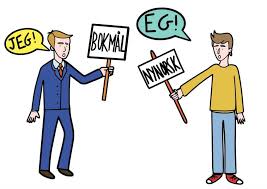“Is Norwegian easy?” is a question any new, or even experienced Norwegian learner has likely pondered at some point. I am certain I am not alone in this habit, but whenever I am interested in learning a new language, be that for fun or for work, I nearly always start by asking myself (and Google) that exact question.
If you know a little bit about the history of the world’s languages and the language families they belong to (and here I do mean a little bit), you will be able to answer that question yourself to a certain extent. Anything that is very different from your own mother tongue will probably be a bit challenging, but if you’ve already learned one foreign language, the second, third and subsequent ones will be easier and easier.
But that doesn’t answer the question at hand. Of all the world’s languages, is Norwegian easy to learn? Let’s try and figure it out, shall we?
Language family and closest languages
Norwegian belongs to the North Germanic language family, which also includes Swedish, Danish, Icelandic and Faroese. The Norwegian language has evolved over time and was heavily influenced by Old Norse, the language spoken by the Vikings. Old Norse was a North Germanic language that spread throughout Scandinavia, Iceland, Greenland, and even parts of Russia.
Speakers of Norwegian, Swedish, and Danish can often understand each other to some degree due to the close relationship between the languages. This can make it easier for foreigners who already speak one of these languages to learn Norwegian.
Since it belongs to the larger Germanic language family, people who already know German might also have an easier time learning Norwegian, since the grammar and syntax are similar, though Norwegian is a lot easier, and some of the vocabulary is also mutually discernible.
Pronunciation features and dialects
Norwegian has a relatively simple pronunciation system, with only 9 vowels and 18 consonants. The language is quite phonetic, meaning that words are pronounced as they are written. However, there are some unique sounds in Norwegian, such as the vowel sounds æ, ø, and å, as well as the different versions of the “r” sound (rolled-R and skarre-R), the “kj” sound and the retroflex consonants.
One thing that is not as easy to get used to is the nearly infinite number of dialects spoken in the country. Your best bet is to learn the standard Eastern Norwegian/Oslo-dialect and take it from there. Fortunately, everyone is nice enough to adapt their speech pattern to foreigners so your ears don’t fall off. We have discussed dialects at length in this blog post if you are interested in learning more about them.

Written standards
We have already discussed this at length in this blog post, but to recap: the Norwegian language has two written forms: Bokmål and Nynorsk.
Bokmål is more widely used and based on the Danish language, while Nynorsk is a newer form of written Norwegian that was created in the 19th century to represent rural dialects.
Grammar and Syntax
One thing that makes Norwegian easy from an English speaker’s standpoint is the grammatical element of the language. Norwegian has a relatively simple grammar system, with three genders (masculine, feminine, and neuter).
Norwegian also has a variety of verb forms, including past tense, present tense, and perfect tense, but they are relatively easy to learn for those who already know English.
Norwegian adjectives inflect for definiteness, gender, number and for comparison (affirmative, comparative and superlative).
As most Indo-European languages, Norwegian is an SVO language. Don’t worry, it simply means that the basic sentence structure is subject – verb – object. So, a simple sentence in Norwegian would look like this:
- Jeg ser på en film. (Norwegian)
- I am watching a movie. (English)
- Estou assistindo a um filme. (Portuguese)
- Je regarde un film. (French)
As you can see, they all have the same structure. If you want to have some fun, add this sentence to Google Translate and test it in different languages. You might be able to tell which ones are similar in structure or not.

